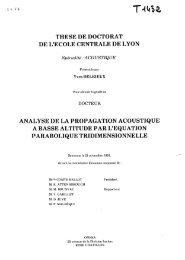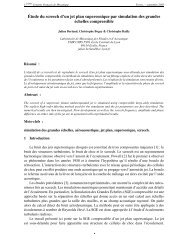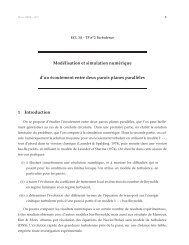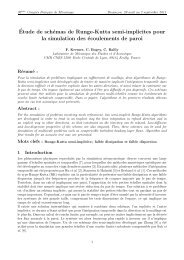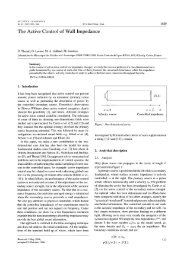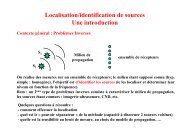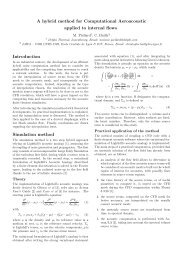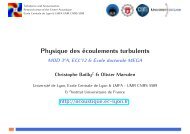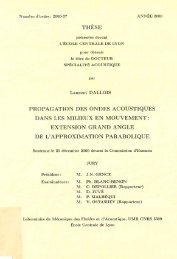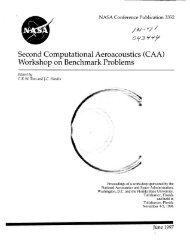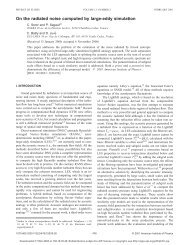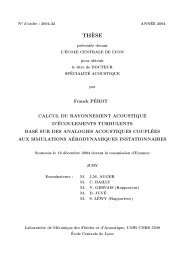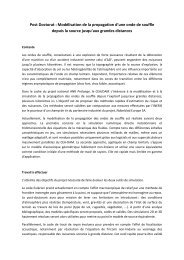ERCOFTAC Bulletin - Centre Acoustique
ERCOFTAC Bulletin - Centre Acoustique
ERCOFTAC Bulletin - Centre Acoustique
You also want an ePaper? Increase the reach of your titles
YUMPU automatically turns print PDFs into web optimized ePapers that Google loves.
(a)<br />
(b)<br />
SPL (dB/Hz)<br />
SPL (dB/Hz)<br />
90<br />
80<br />
70<br />
60<br />
50<br />
40<br />
0 1 2 3 4.5<br />
St<br />
100<br />
90<br />
80<br />
70<br />
60<br />
50<br />
40<br />
0 1 2 3 4.5<br />
St<br />
Figure 2: Far field acoustic spectra measured at a polar<br />
angle θ = 110 ◦ . baseline nozzle, notched nozzle.<br />
(a) Mj = 1.10, (b) Mj = 1.35. SPL denotes sound pressure<br />
level.<br />
nozzle. They are set every 10 ◦ from 30 ◦ to 150 ◦ . In<br />
the following, polar angles are measured from the downstream<br />
jet axis. Near field acoustic data are also acquired<br />
using four 3.175 mm diameter GRAS transducers located<br />
at a distance of the order of one jet diameter from the<br />
lipline, depending on the operating condition of the jet.<br />
The microphones are set perpendicular to the jet axis<br />
and are mounted on an axial traverse. All microphone<br />
signals are sampled at 102400 Hz by a National Instrument<br />
PXI 5733 board.<br />
A Z-type schlieren system, mounted on an axial traverse<br />
downstream of the nozzle exit, has been used to<br />
visualize flows exhausting through both nozzles. It consists<br />
of a light-emitting diode, two f/8, 203.2 mm diameter<br />
parabolic mirrors, a knife-edge and a high-speed numerical<br />
camera.<br />
Static pressure measurements have been performed by<br />
means of short static probes, as designed by Pinckney<br />
[13]. The diameter of the probes is 1.5 mm and the<br />
holes are located approximately 4.7 mm from the tip.<br />
Their compact geometry aims at solving the difficulty<br />
of measuring pressure in a flow with high gradients.<br />
Such probes have been extensively used for shock-cell<br />
structure characterizations, especially in connection with<br />
broadband shock-associated noise [14].<br />
2.2 Screech reduction<br />
Far field acoustic spectra are displayed in Figure (2) for<br />
Mj = 1.10 and 1.35 at a polar angle θ of 110 ◦ . They<br />
are plotted against the Strouhal number expressed as<br />
St = fDj/Uj, with f the frequency, Dj the fully expanded<br />
jet diameter and Uj the perfectly expanded velocity.<br />
It is evident that the notches are very effective at<br />
Mj = 1.35. However, the screech reduction is smaller at<br />
Mj = 1.10. The same conclusions can be reached when<br />
examining other polar angles.<br />
P s / P amb<br />
1.7<br />
1.5<br />
1.3<br />
1.1<br />
0.9<br />
0.7<br />
0.5<br />
−1 0 1 3 5 7 9 11 13<br />
x/D<br />
Figure 4: <strong>Centre</strong>line static pressure profiles, Mj = 1.35.<br />
◦ baseline nozzle, ▽ notched nozzle. Pamb is the ambient<br />
pressure, x the axial coordinate and D the relevant<br />
nozzle diameter.<br />
3 Aerodynamical effects of the<br />
notches<br />
The influence of the nozzle indentation on the jet development,<br />
especially on the shock-cell structure, is<br />
now considered. It was recalled in the Introduction<br />
that intrusive screech-suppressing methods, such as tabs,<br />
deeply altered the shock structure. It is essential that the<br />
effect of the cancelling technique be as small as possible<br />
in order to be able to relate unambiguously any change<br />
in the broadband shock-associated noise shape to screech<br />
reduction only.<br />
Mean schlieren pictures obtained by averaging of 500<br />
instantaneous images sampled at 500 Hz are displayed in<br />
Figure (3) for Mj = 1.35. Each picture results from a collage<br />
of four partial mean images taken at different axial<br />
stations along the jet. Because of its indentation, it is<br />
not clear where the shock-cell structure actually starts in<br />
the case of the notched nozzle. To circumvent this question,<br />
the first shocks of both jets are axially aligned. The<br />
subsequent shock-cell development can then be directly<br />
compared.<br />
The jet development is not strongly affected by the<br />
change in the nozzle lip geometry. The shock system remains<br />
axisymmetric in the case of the notched nozzle.<br />
Furthermore, the shock spacing between baseline and<br />
notched case seems to be only slightly changed. The second<br />
shock-cell is shorter with the notched nozzle, but the<br />
shock spacing then remains approximately unchanged afterward.<br />
An ejection is induced through the slits, especially<br />
visible on the vertical ones, due to the pressure<br />
ratio across them between jet and ambient. This also<br />
produces a more complex pattern in the first shock-cell.<br />
It is evident that the shock system extends further<br />
downstream for the notched nozzle, with more shocks<br />
being visible. It is believed that screech is responsible<br />
for a quicker damping of the shock-cell structure.<br />
Measurements of static pressure Ps have been performed<br />
on the jet centreline at Mj = 1.35 with both nozzles.<br />
The results, displayed in Figure (4), are in line<br />
with the schlieren visualizations : the extension of the<br />
shock-cell structure is clearly visible here. However, the<br />
strength of the first shock cells, which can be seen as the<br />
oscillation amplitude of the static pressure, is very similar<br />
for both nozzles. This quantitatively proves that the<br />
notched nozzle does not disrupt much the jet development.<br />
Finally, it has to be noted that the Ps profiles for<br />
the notched nozzle have been translated downstream by<br />
4 mm, the slit depth, for the first shocks to be approximately<br />
aligned with their baseline counterparts.<br />
<strong>ERCOFTAC</strong> <strong>Bulletin</strong> 90 11



